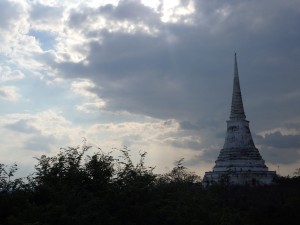 Now I’m fortunate enough that I am currently living within 1 hour of many spectacular Wats and shrines.
Now I’m fortunate enough that I am currently living within 1 hour of many spectacular Wats and shrines.
Phra Nakhon Khiri is one said place, being an historical park situated on a forested hillside at the edge of Phetchaburi, overlooking the city and can be seen from the highway if you are heading south towards Hua Hin.
Originally built by King Rama IV (King Mongkut), it is a testament to the wealth that has previously been seen in Thailand. Back in 1858, this site was a thriving complex of religious buildings, villas and throne halls.
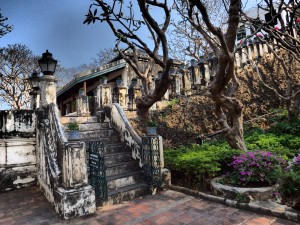 King Rama IV and King Rama V used Phra Nakhon Khiri as a summer palace and a place to entertain important dignitaries. The name of Phra Nakhon Khiri translates to Holy City Hill, Thai locals know it better as Khao Wang, meaning hill with palace.
King Rama IV and King Rama V used Phra Nakhon Khiri as a summer palace and a place to entertain important dignitaries. The name of Phra Nakhon Khiri translates to Holy City Hill, Thai locals know it better as Khao Wang, meaning hill with palace.
Upon arriving at the temple, you will gain access to the top of the hill via a very modern looking cable car. You ascend quickly in the cable car up onto the 92m high hill.
The entry price for a farang is 200thb, and on first inspection of the temple from the ground this looks like it is well over priced.
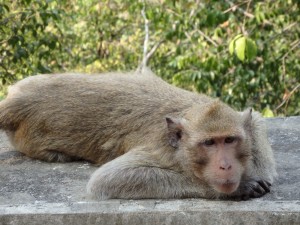 It is not until you reach the top, that you are over whelmed by the amount of ground the palace actually takes up. There are many warning signs when you first get to the top indicating that you need to be very wary of the monkey’s with the grounds.
It is not until you reach the top, that you are over whelmed by the amount of ground the palace actually takes up. There are many warning signs when you first get to the top indicating that you need to be very wary of the monkey’s with the grounds.
Take heed of this, as with most places that have a monkey colony. They can sometimes be aggressive, especially if provoked.
The historical park consists of three structure groups, located on three separate peaks joined by manicured gardens and paved walking paths.
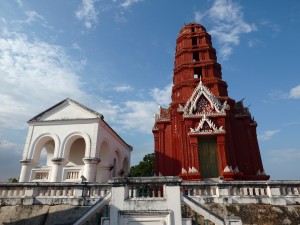 The site itself was registered as a historical park in August 1979, with two of the palaces housing a branch of the Thai National Museum.
The site itself was registered as a historical park in August 1979, with two of the palaces housing a branch of the Thai National Museum.
On the peaks, you will find several Wats, the central peak houses a large chedi named Phra That Chom Phet, with the eastern peak housing Wat Phra Kaeo, the royal temple, built in similar fashion to the Wat Phra Kaeo in Bangkok.
With the grounds beautifully presented, I found myself wishing I had more time to explore the site, and even take time out to just sit and enjoy my surrounds.
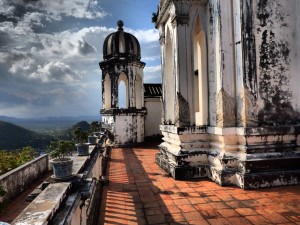 As you climb the many stairs to explore the Wats, I couldn’t help but feel that site has some what of a French Provincial feel, with a twist of Asia.
As you climb the many stairs to explore the Wats, I couldn’t help but feel that site has some what of a French Provincial feel, with a twist of Asia.
The use of white marble, which is now showing signs of age, the timber shutters and gardens all amount to me feeling this site could be situated anywhere in Europe.
Although Phra Nakhon Khiri is no longer in use by the Thai royal family, it’s heritage still maintains certain traditional protocols.
Visitors are encouraged to cover their knees and shoulders and also show restraint with no photography inside the main museum.
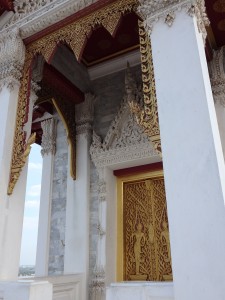 Personally, this site is up there on my Top 5 list of Wats and Temples to visit in Thailand. Soaking up the sun late afternoon, casually walking the many paths, and exploring the grounds was something exceptionally inspirational for me.
Personally, this site is up there on my Top 5 list of Wats and Temples to visit in Thailand. Soaking up the sun late afternoon, casually walking the many paths, and exploring the grounds was something exceptionally inspirational for me.
The only downside for me was that the main museum was closed for renovations until January 18th 2016, not so bad as this means I will need to make a second pilgrimage to the site later in the year to explore the museum and ground further.
If your in the region, I can’t suggest highly enough the need to add Phra Nakhon Khiri to your list of places to visit.
How to get there: Phetchaburi is approximately 1.5 hours south of Bangkok or 1 hour north from Hua Hin. Mini-Buses depart from Victory Monument in Bangkok. Regular buses also depart from Hua Hin and Cha Am.
[spider_facebook id=”2″]
[embedyt]https://www.youtube.com/watch?v=WoBA9pmK1uU[/embedyt]

One thought on “Is Phra Nakhon Khiri Historical Park the best in Thailand?”
Comments are closed.